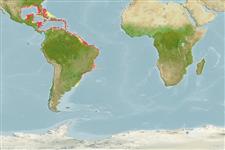Teleostei (teleosts) >
Eupercaria/misc (Various families in series Eupercaria) >
Haemulidae (Grunts) > Haemulinae
Etymology: Anisotremus: Greek, anisos = unequal + Greek, trema, -atos = hole (Ref. 45335).
More on author: Bloch.
Environment: milieu / climate zone / depth range / distribution range
Ecology
Marine; reef-associated; depth range 0 - 70 m (Ref. 9710), usually 0 - 15 m (Ref. 40849). Subtropical; 31°N - 35°S, 98°W - 28°W
Western Atlantic: Florida, USA and the Bahamas through the Gulf of Mexico and the Caribbean Sea to Brazil.
Size / Weight / Age
Maturity: Lm ? range ? - ? cm
Max length : 76.0 cm TL male/unsexed; (Ref. 40637); common length : 45.0 cm TL male/unsexed; (Ref. 3798); max. published weight: 5.8 kg (Ref. 40637)
Dorsal
spines
(total): 12;
Dorsal
soft rays
(total): 18;
Anal
spines: 3;
Anal
soft rays: 9. Front half of body darker than rear. Soft dorsal and anal fins have dense scales on bases of interradial membranes (Ref. 26938). Fins dusky, anal and pelvic fins darkest; peritoneum not black; young with two black stripes and a black spot at base of caudal fin (Ref. 13442).
Maximum depth from Ref. 126840. Inhabits larger patch reefs and quickly sloping rocky bottoms. Often near the shelter of caves, ledges, or wrecks (Ref. 9710). Feeds at night on crustaceans, mollusks, smaller fish, and the long-spined urchin, Diadema. Marketed fresh.
Life cycle and mating behavior
Maturity | Reproduction | Spawning | Eggs | Fecundity | Larvae
Distinct pairing during breeding (Ref. 205).
Robins, C.R. and G.C. Ray, 1986. A field guide to Atlantic coast fishes of North America. Houghton Mifflin Company, Boston, U.S.A. 354 p. (Ref. 7251)
IUCN Red List Status (Ref. 130435)
Threat to humans
Reports of ciguatera poisoning (Ref. 30303)
Human uses
Fisheries: commercial; aquarium: public aquariums
More information
ReferencesAquacultureAquaculture profileStrainsGeneticsElectrophoresesHeritabilityDiseasesProcessingNutrientsMass conversion
Tools
Can't connect to MySQL database fbquizv2. Errorcode: Too many connections
